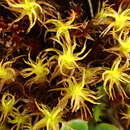Comments
(
Inglês
)
fornecido por eFloras
Didymodon giganteus commonly forms large tufts on slopes and ledges in the far North. Several specimens, collected in Alaska, have been seen with the above combination of characters, which is that of European specimens. Many collections, however, that had been previously identified as this species but having weak trigones are either D. ferrugineus or D. maximus.
- licença
- cc-by-nc-sa-3.0
- direitos autorais
- Missouri Botanical Garden, 4344 Shaw Boulevard, St. Louis, MO, 63110 USA
Description
(
Inglês
)
fornecido por eFloras
Plants large to robust, 12–20 cm high, dark green to reddish brown, in loose tufts. Stems erect, usually branched. Leaves contorted when dry, strongly squarrose when moist, triangularly broad-ovate at the base, narrowly lanceolate toward to the apex; margins entire, revolute in the lower half, somewhat undulate in the upper half; costa slender, percurrent, reddish brown; upper leaf cells triangular to pentagonal, strongly thick-walled, with 1 to several low papillae; basal cells narrowly rectangular, thick-walled, porose, smooth.
- licença
- cc-by-nc-sa-3.0
- direitos autorais
- Missouri Botanical Garden, 4344 Shaw Boulevard, St. Louis, MO, 63110 USA
Description
(
Inglês
)
fornecido por eFloras
Plants red-brown. Stems often 3-5 cm, central strand present. Stem leaves appressed when dry, spreading or weakly recurved and keeled when moist, monomorphic, elliptic-lanceolate, adaxially grooved along costa, (2-)2.5-4 mm, base scarcely differentiated in shape to elliptic, margins nearly broadly recurved in proximal 1/3-3/4 of leaf, entire, apex acute or gradually acuminate, not fragile; costa percurrent, tapering and distinctly widened at base, widened pad of cells absent, adaxial costal cells elongate, 5-7 cells wide at mid leaf, guide cells in 1 layer; basal laminal cells differentiated medially, rectangular, walls thickened and porose; distal laminal cells 13-15 µm wide, 1:1 or occasionally transversely elongated, papillae absent or simple, low, present only on the back of the leaf near the apex, lumens angular, walls irregularly thickened and trigonous with trigones about the same size as the lumens, weakly convex on both sides, 1-stratose. Specialized asexual reproduction specialized structures absent. Sexual condition sterile. Sporophytes not seen. Distal laminal KOH reaction dark red.
- licença
- cc-by-nc-sa-3.0
- direitos autorais
- Missouri Botanical Garden, 4344 Shaw Boulevard, St. Louis, MO, 63110 USA
Distribution
(
Inglês
)
fornecido por eFloras
Distribution: China, Sikkim, Japan, Europe, and North America.
- licença
- cc-by-nc-sa-3.0
- direitos autorais
- Missouri Botanical Garden, 4344 Shaw Boulevard, St. Louis, MO, 63110 USA
Habitat
(
Inglês
)
fornecido por eFloras
Habitat: on rocks in shade, thin soil over rocks, soil in grassland or on rotten trees.
- licença
- cc-by-nc-sa-3.0
- direitos autorais
- Missouri Botanical Garden, 4344 Shaw Boulevard, St. Louis, MO, 63110 USA
Synonym
(
Inglês
)
fornecido por eFloras
Geheebia gigantea (Funck) Boul., Musc. France 395. 1884.
Didymodon levieri Broth. in Levier, Nuovo Giorn. Bot. Ital., n. ser. 13: 256. 1906.
Didymodon subrufus Broth., Symb. Sin. 4: 38. 1929. Type. China: Sichuan (Setschwan), Yan-yuan (Yenyuan) Co., Handel-Mazzetti 2353 (holotype H).
- licença
- cc-by-nc-sa-3.0
- direitos autorais
- Missouri Botanical Garden, 4344 Shaw Boulevard, St. Louis, MO, 63110 USA
Synonym
(
Inglês
)
fornecido por eFloras
Barbula gigantea Funck, Flora 15: 483. 1832; Geheebia gigantea (Funck) Boulay
- licença
- cc-by-nc-sa-3.0
- direitos autorais
- Missouri Botanical Garden, 4344 Shaw Boulevard, St. Louis, MO, 63110 USA
Didymodon giganteus
(
Alemão
)
fornecido por wikipedia DE
Didymodon giganteus (deutsche Namen sind Großes Doppelzahnmoos und Blaugrünes Doppelzahnmoos) ist eine Laubmoos-Art aus der Familie Pottiaceae.
Merkmale
Das Moos bildet lockere, bis 15 Zentimeter hohe, braungrüne bis rotbraune Polsterrasen. Die Blätter sind trocken kraus, feucht stark zurückgebogen. Sie sind aus breit eiförmiger Basis in eine schmal lanzettliche Spitze verschmälert. Die Blattränder sind ganzrandig und unten umgerollt, die rotbraune Blattrippe reicht bis in die Blattspitze. Die Laminazellen sind oben teilweise rundlich, teilweise drei- bis fünfeckig oder sternförmig, papillös und immer stark dickwandig, unten verlängert, getüpfelt und stark unregelmäßig buchtig verdickt.
Sporophyten sind unbekannt.
Didymodon giganteus unterscheidet sich von anderen Arten der Gattung besonders durch die Größe der Pflanzen und durch die Laminazellen mit stark buchtig verdickten Zellwänden.
Systematik
Die Art wurde lange in der monotypischen Gattung Geheebia Schimp. als Geheebia gigantea (Funck) Boulay geführt. Nach Ergebnissen aus molekularsystematischen Studien wird sie nunmehr der Gattung Didymodon zugeordnet.
Verbreitung und Standortansprüche
Didymodon giganteus kommt in Europa, Asien und in Nordamerika vor. In Mitteleuropa ist das Moos in den Kalkalpen ziemlich verbreitet, hier steigt es bis in die alpine Höhenstufe und wächst an frischen bis feuchten, lichtreichen bis halbschattigen Stellen auf steinigen Böden, Mergel, Kalk-, Dolomit- und kalkhaltigem Silikatgestein. Frühere Vorkommen in Kalkmooren des Alpenvorlandes sind beinahe erloschen.
Literatur
Weblinks
– Album mit Bildern, Videos und Audiodateien

- licença
- cc-by-sa-3.0
- direitos autorais
- Autoren und Herausgeber von Wikipedia
Didymodon giganteus: Brief Summary
(
Alemão
)
fornecido por wikipedia DE
Didymodon giganteus (deutsche Namen sind Großes Doppelzahnmoos und Blaugrünes Doppelzahnmoos) ist eine Laubmoos-Art aus der Familie Pottiaceae.
- licença
- cc-by-sa-3.0
- direitos autorais
- Autoren und Herausgeber von Wikipedia
Didymodon giganteus
(
Vietnamita
)
fornecido por wikipedia VI
Didymodon giganteus là một loài Rêu trong họ Pottiaceae. Loài này được (Funck) Jur. mô tả khoa học đầu tiên năm 1882.[1]
Hình ảnh
Chú thích
Liên kết ngoài
- licença
- cc-by-sa-3.0
- direitos autorais
- Wikipedia tác giả và biên tập viên
Didymodon giganteus: Brief Summary
(
Vietnamita
)
fornecido por wikipedia VI
Didymodon giganteus là một loài Rêu trong họ Pottiaceae. Loài này được (Funck) Jur. mô tả khoa học đầu tiên năm 1882.
- licença
- cc-by-sa-3.0
- direitos autorais
- Wikipedia tác giả và biên tập viên

